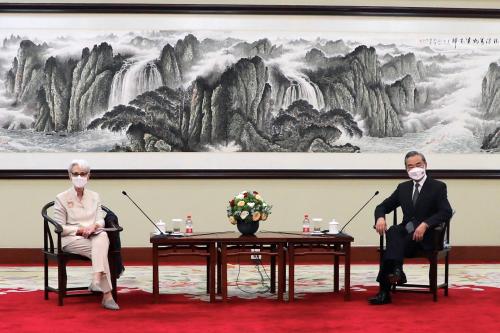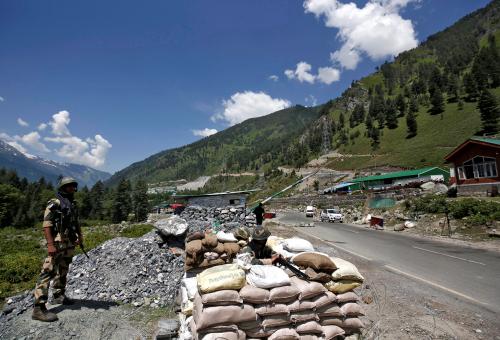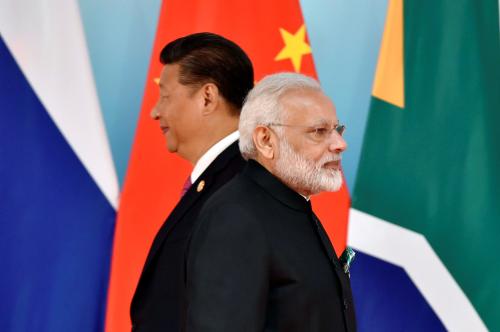On October 23, China adopted a land border law, which will take effect on January 1, 2022, in an endeavor to strengthen its border control and protection. Like the coast guard law and maritime traffic safety law enacted earlier this year, the new law is passed amid heightened tensions between China and its neighbors over border disputes. On its land periphery, China has been locked in a protracted face-off with India along their disputed border since May 2020. While the new law has galvanized speculations as to whether it would be used to justify a more assertive Chinese posture, it clearly goes beyond that specific dispute and speaks to a host of problems as Beijing strives to secure its land border amid growing uncertainty in its neighborhood.
WHAT DOES THE LAW SAY?
Through the enactment of this new law, Beijing appears to be signaling determination to resolve the border disputes on its preferred terms. The law sets an overall tone of resolve upfront, stating that China will “resolutely defend territorial sovereignty and land border security” while continuing to seek to settle disputes through negotiations.
In streamlining the division of labor among various bureaucracies including the foreign ministry, the public security ministry, and the customs and immigration administrations, the law specifies that the People’s Liberation Army (PLA) and the paramilitary People’s Armed Police (PAP), both under the command of the Central Military Commission, will bear the major responsibility for safeguarding land border, resisting armed invasion, and responding to major contingencies. It authorizes patrol officers to use police instruments and weapons against intruders who resort to violence in resisting detention and threaten the safety of life and property of other people. It also authorizes the bureaucracies to collaborate with neighboring countries in combating the “three evils” of terrorism, separatism, and religious extremism.
The law notably emphasizes the role of Chinese citizens and civilian institutions in supporting the PLA and PAP — a likely manifestation of the “civil-military fusion strategy” in land border defense. A comparison of an earlier draft of the law and the final text is revealing in this regard. The draft released in August includes only one sentence requiring citizens and civilian organizations to assist the PLA and PAP. In the final text, this sentence is expanded into a separate clause. The newly added clause requires local governments in border areas to allocate resources to strengthen the building of “mass defense groups” (群防队伍建设) to support border defense missions. The concept of “mass defense” for borders, according to writings by Chinese security analysts, means to draw on local residents to assist with missions including information collection, order maintenance, and sovereignty and territorial defense.
The law outlines four conditions that can prompt border shutdown, port closure, or other “emergency measures”:
- when a war or armed conflict breaks out on the periphery and threatens China’s border security and stability;
- when a major incident poses a grave threat to national security or the life and property of residents in the border area;
- when the border area is threatened as a result of a natural disaster, public health incident, or nuclear, biological, or chemical pollution;
- other situations that seriously impact the land border and security and stability in border areas.
The law also reiterates the state’s commitment to opening up these areas to the outside world and improving local public service and infrastructure, aiming to strike a balance between border defense and socioeconomic development. The law also pledges state support for constructing border towns with improved functions and capacity and cross-border cooperation zones to promote trade, tourism, and ecological protection.
WHY THIS LAW AND WHY NOW?
Several factors seem to have motivated the adoption of the law now. First, this law reflects Beijing’s renewed concerns over the security of its land border while it confronts a slew of unsettled disputes on its maritime front. Unlike the coast guard law long pushed for by China’s maritime security agencies, calls for legislation governing land border defense seem more sporadic, probably because China settled most of its land border by the early 2000s and has since faced a relatively stable frontier. But the confrontations on the Sino-Indian borders in recent years may have reminded Beijing that as a classic land-sea power (海陆复合型国家), China must always ready itself to cope with threats in both the continental and maritime domains.
Second, the COVID-19 pandemic also underscores the imperative for Beijing to exert greater control over its somewhat porous land border. In April 2020, when the virus had been contained inside China but was rapidly spreading worldwide, the Chinese State Council warned of a growing risk of cross-border transmission and prioritized prevention in frontier areas. The latest wave of breakouts in border towns in Yunnan, Xinjiang, and Inner Mongolia only reinforce that assessment.
Moreover, this law reflects Beijing’s thinly-veiled worries about the stability of its hinterland bordering Central Asia. The withdrawal of U.S. forces and Taliban takeover aggravated Beijing’s concerns that an Afghanistan bogged down in protracted turmoil and humanitarian disasters may become a hotbed for terrorism and extremism that could spread to Xinjiang.
Domestic politics may also be at play. The law enshrines President Xi Jinping’s signature ethnic minority policy line, “forging a consciousness of the common identity of the Chinese nation” (铸牢中华民族共同体意识) through strengthened propaganda and indoctrination. Criticized by some observers as a euphemism for coercive ethnic assimilation, this policy was proposed by Xi at the 2014 central conference on Xinjiang, endorsed in his 19th Party Congress report in 2017, and reiterated at central conferences on Tibet and Xinjiang in 2020. It is noteworthy that the earlier draft of the law contains only one sentence referring to the need to reinforce Chinese citizens’ “homeland security consciousness” without mentioning Xi’s formula. The final text expands this sentence into a separate clause and adds Xi’s phrase, a move probably intended to further bolster his standing in the lead-up to the 20th Party Congress next year when he would secure a third term.
THE LAW’S IMPLICATIONS
In the context of Sino-Indian disputes, enforcing the law could be problematic in several ways. First, although the line of actual control (LAC) has served as a de facto border between China and India since their 1962 war, the two sides disagree over where it lies in at least 13 locations. Given the lack of a mutually acceptable border, how China handles Indian personnel it sees as illegally crossing the border may have a nontrivial bearing on developments along the border.
Second, the law prohibits the construction of permanent facilities near China’s border without permission from Chinese authorities. The vague wording could be interpreted to include both sides of the border, creating the potential for additional frictions as both China and India have engaged in an “infrastructure arms race” on their respective sides of the LAC.
Third, with an emphasis on the development of border towns and the role of civilians, the law may raise questions about whether Beijing intends to expand or accelerate civilian settlement in areas bordering India, Nepal, and Bhutan. While border town development resonates with China’s domestic agenda of “developing the border regions, enriching the local people” (兴边富民) articulated in 1999 and integrated into China’s five-year plans, it may be perceived as legitimizing a land version of the “salami-slicing” tactic that China is seen as employing in its maritime disputes.
This law also tackles issues unique to China’s border with North Korea by prohibiting using sound, lighting, or signs; floating materials through air or water; or engaging in other activities near the border that may affect China’s “friendly relations” with neighboring countries. This resembles a recent South Korean law banning activist groups and defectors from sending materials critical of the North Korean regime across the 38th parallel.
Domestically, to the extent that Beijing sees a close link between reinforcing a “common identity of the Chinese nation” and consolidating control over China’s ethnic minority-populated land frontier, as is clear in this law, modulation in Beijing’s current policy toward these regions may not be over the horizon.
In the future, Beijing could invoke the law to close China’s border to prevent the spillover of terrorism and extremism from Central Asia, an influx of refugees from North Korea, Myanmar, or Afghanistan, or the spread of a pandemic.
While China might see a legitimate need for a legal framework to manage a more than 22,000-kilometer land border with 14 neighboring countries, it can maintain some wiggle room in implementation and control the risk of unexpected incidents especially along the unsettled border. India is likely to stand its ground, but should communicate to Beijing that additional incidents would be in neither side’s interest and would only reinforce the current diplomatic impasse in negotiating for disengagement. As for the United States, it should raise its concerns to Beijing about the potential implications of the law, but should do so through diplomatic channels to avoid putting Beijing in a position where it feels it must defy Washington by aggressively enforcing the law.










Commentary
China’s land border law: A preliminary assessment
November 4, 2021